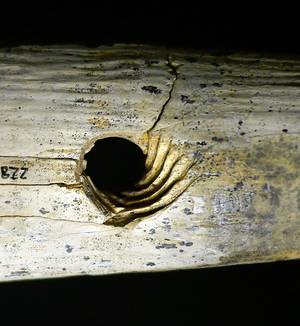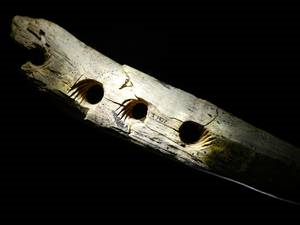40,000 years of rope-making
A new superlative find by Nicholas Conard and his team at Hohle Fels
The Ice Age rope-making tool
We reported already about the extraordinary finds made by palaeontologist Nicholas Conard and his team of the University of Tübingen, in Germany, in the cave of Hohle Fels, in the Swabian Jura, in southerwestern German. Among them, the earliest human representation known (the "Venus") dated to -35,000y to -40,000y, and the oldest musical instruments discovered to date, three bone flutes, now dated to -42,000y. See: The Ice Age Flute
This year, the team has made history again, with an astounding discovery: a rope-making tool, dated to 40,000y. It is made of a piece of mammoth bone and displays three holes, exquisitely carved with fine spiral grooves to facilitate the rope-making process - constituting, very likely, a "high-tech" improvement over "older" models (of which none have been found to this day). The implications of this find are extraordinary: humans knew how to make ropes and process fiber much earlier than ever thought - and probably much earlier than the date of the artefact found this summer. Before this day, there existed no earlier sign of the existence of ropes than an imprint in clay dated to -28,000 years, and what seemed a fragment of a two-ply rope, found at Lascaux, dated to -15,000 years. The new tool discovered would have produced three-ply ropes. Could the humans of 40,000 years ago have had some form of a textile industry, as well? Commodities were not lacking - one of those wholly mammoths they were hunting would have yielded a pile of fibre... Some researchers believe to make out folds of clothing over the body of the "Venus" - but this is far from established. It should also make us, in all modesty, revise and dismiss the crude image of hirsute and unkempt early humans which populate our imaginations: people able to make rope must have long before mastered the art of braiding their hair...
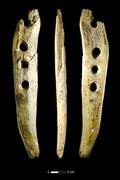
Rope making tool from mammoth ivory from Hohle Fels Cave in southwestern Germany, ca. 40,000 years old. Photo: Copyright University of Tübingen
Prof. Nicholas Conard and members of his team, present the discovery of a tool used to make rope in today‘s edition of the journal: Archäologische Ausgrabungen Baden-Württemberg.
Rope and twine are critical components in the technology of mobile hunters and gatherers. In exceptional cases impressions of string have been found in fired clay and on rare occasions string was depicted in the contexts of Ice Age art, but on the whole almost nothing is known about string, rope and textiles form the Paleolithic.
A key discovery by Conard’s team in Hohle Fels Cave in southwestern Germany and experimental research and testing by Dr. Veerle Rots and her team form the University of Liège is rewriting the history of rope.
The find is a carefully carved and beautifully preserved piece of mammoth ivory 20.4 cm in length with four holes between 7 and 9 mm in diameter. Each of the holes is lined with deep, and precisely cut spiral incisions. The new find demonstrates that these elaborate carvings are technological features of rope-making equipment rather than just decoration.
Similar finds in the past have usually been interpreted as shaft-straighteners, decorated artworks or even musical instruments. Thanks to the exceptional preservation of the find and rigorous testing by the team in Liège, the researchers have demonstrated that the tool was used for making rope out of plant fibers available near Hohle Fels. “This tool answers the question of how rope was made in the Paleolithic”, says Veerle Rots, “a question that has puzzled scientists for decades.”
Excavators found the rope-making tool in archaeological horizon Va near the base of the Aurignacian deposits of the site. Like the famous female figurines and the flutes recovered from the Hohle Fels, the rope-making tool dates to about 40,000 years ago, the time when modern humans arrived in Europe. The discovery underlines the importance of fiber technology and the importance of rope and string for mobile hunters and gatherers trying to cope with challenges of life in the Ice Age.
Prof. Conard’s team has excavated at Hohle Fels over each of the last 20 years, and it is this long-term commitment that has over and over again paid off, to make Hohle Fels one of the best known Paleolithic sites worldwide. Hohle Fels and neighboring sites from the Ach and Lone Valleys have been nominated for UNESCO World Cultural Heritage status. The excavations at Hohle Fels near Schelklingen in the Ach Valley are funded by the HeidelbergCement AG, the Ministry of Science of Baden-Württemberg and the Heidelberger Academie of Sciences.
The rope-making tool will be on exhibit at the Urgeschichtliches Museum in Blaubeuren starting Saturday, July 23rd . (www.urmu.de)
Publication:
Nicholas J. Conard, Maria Malina: Außergewöhnliche neue Funde aus den aurignacienzeitlichen Schichten vom Hohle Fels bei Schelklingen. Archäologische Ausgrabungen in Baden-Württemberg, S. 61-66, 22 July 2016.

videos
Video: how the rope-making tool would have been used (University of Liège, Belgium)
The Hohle Fels Cave
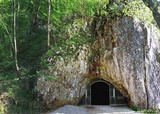
The Hohle Fels cave is situated in the South-West of Germany, in the Swabian Jura, about one kilometer from the town of Schelklingen. 40,000 years ago, this area was situated between two glaciers : the one, the largest in expanse, which covered all the North of Europe, and the smaller one which covered the Alps. Plains of frozen steppe were criss-crossed by mammoths, cave lions, reindeers and horses…
The cave (which is situated 534 m above sea-level) is made up of a first chamber from which runs a tunnel of almost 30m leading to a larger cavity, covering some 500 sqm, with height of 12 meters. These dimensions make into one of the largest caves in this area of southwestern Germany. As no human remains have been found in the cave, it is impossible to determine if it was visited by Neanderthals or by Homo sapiens, or both. We know that the humans who visited it had to share it with hibernating cave bears.
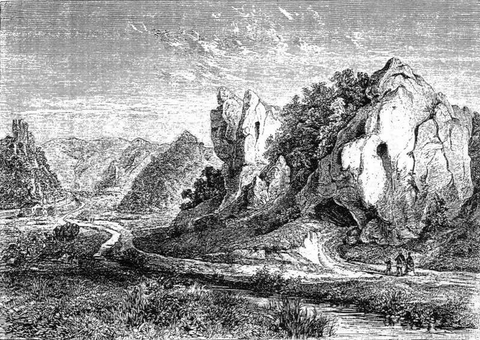
The entrance to the cave was visible enough to be known by the inhabitants of the area. There was no discovery, properly speaking. Excavations on the site started in 1870/1871. They were lead by the pastor and palaeontologist Oscar Fraas who had recognized by chance some bones found in the cave, which were being sold as fertilizer. They allowed him to bring to day remains of fauna (bears, mammoth, reindeer, horses…) and tools dating back to the Aurignacian. From 1906 to 1912, prehistorian Robert Rudolf Schmidt took up Fraas’ excavations, but made no notable discoveries. But he identified two archaeological levels for the artefacts found by Fraas: Aurignacian and Magdalenian.
From 1958 to 1990, successive teams get to work: Gerlinde Matschak et Gustav Riek, then Bernhard Mangold, Andreas Poehler, Helmut Frank. From 1977, Joachim Hahn takes on the site, now financed by the Institute of Prehistory of the University of Tübingen.
Since 1997, annual excavations have been lead by prehistorian achaeologist Nicholas Conard, of University of Tübingen. Almost every year has brought its lot of discoveries, confirming the extraordinary richness and complexity of the site.
Earlier finds: Aurignacian (started ca 43,000 y ago)

Gravettian (started ca. 26,000 y ago)
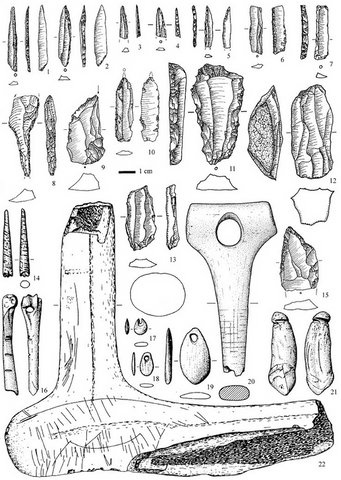
The huge number of pieces discovered indicates regular human occupancy over thousands of years. Because of climatic conditions and of the history of the Hohle Fels cave, the walls of the cave appear to be devoid of any drawings or engravings. However, since 1998, the team lead by Nicholas Conard has identified on the ground several blocks of limestone with marks of paint. These could in fact be parts of the walls which have come down. Dated to –15 000 ans (Magdalenian), if these pieces did indeed fall from the walls, it makes them the only witnesses to parietal art in Central Europe for this period. Pieces of hematite and ochre, which could have been used for making drawings, were found in the strata (picture below):
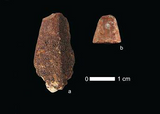
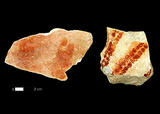
Dotted silt-stone
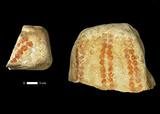
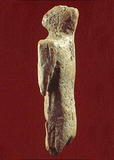
But it’s in the domain of portable art that the cave of Hohle Fels reveals at once an enormous diversity and richness. The artefacts are numerous, but they are also the oldest found in their category. The small statuettes all come from the Aurignacian level of the Hohle Fels stratigraphie. They were radiocarbon-dated to between – 35 000 and – 42 000 years.
The anthropomorphic statuette of Hohle Fels, made of mammoth ivory, measures 25 mm in height. The general shape, the shoulders, torso and ams evoke a man, whereas the head makes one think of an animal such as a lion. This mini-sculpture must be compared with the statuette of the lion-man found at the cave of Hohlenstein-Stadel, also in the Swabian Jura, which is much larger: 29.6 cm.
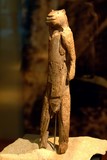
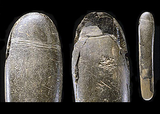
The phallus, discovered in 2005, measures 20 cm in length. It was reconstituted from the 14 pieces into which it had broken. The object was made from a single stone, and polished. Additionally to its sexual connotation, it may have been used to cut silex tools.
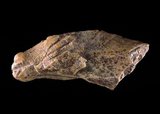
Discovered in 2002, the head of an animal, probably a horse (maybe a bear), sculpted in mammoth ivory. The lines of the eyes and of the mouth are enhanced with fine grooving. The head measures 38 mm in length. [This is really tiny, and adding 'fine grooving' denotes excellent vision, digital coordination and skill.]

Flying bird in mammoth ivory made some 30 000 years ago, the oldest bird sculpture known. It was found broken in two pieces in 2002, the statuette measures 38mm in length and shows a bird diving. It could be either a duck or a goose. [As for the horse, notice the tension of movement in the head - something that is easy for us to capture from life in photography, but which indicates a very acute visual memory on the part of the artist.]
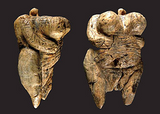
"Venus," discovered in 2008, dated between -35 et -40 000 years. To this day, the most ancient sculpted human representation. 6 cm high, 3,5 cm wide, 3 cm thick, the ring in place of the head suggests that it was worn as a pendant jewel.
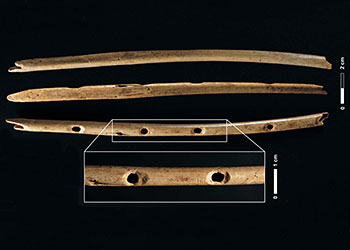
Pieces of 3 flutes, dated at first to 35 000 years, re-estimated to – 42 000 years in 2012. The flutes are each made of a different material each: swan bone, vulture bone, mammoth ivory. They have either five or three holes, depending on size. They were found in the Aurignacian archaeological levels, and attest to prehistoric music-making. The biggest and best preserved of them (in 12 fragments) is made of a vulture bone, 21,8 cm long with a diameter of 0,8 cm. See Q-MAG.org: The Ice Age Flute
[Our miraculous human Music must have existed long before this time. DNA studies combined with musicology suggest that there existed elaborate polyphonic singing in Africa from some time between -102,000 and -77,000 years ago, i.e. before the move "Out of Africa" of early Homo Sapiens sapiens: See Victor Grauer: Echoes of our forgotten Ancestors. The Neanderthals they met were also musically gifted... ]
Section on Hohle Fels Cave translated from the French and adapted by Anne-marie de Grazia from an article in hominides.com
NEW: Amanda Laoupi: Pushing the Limits



